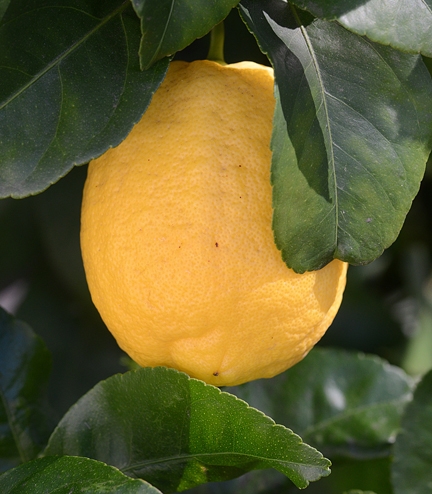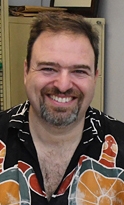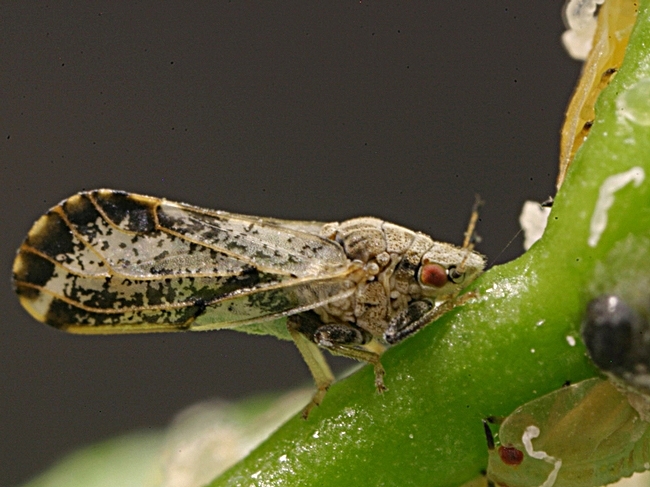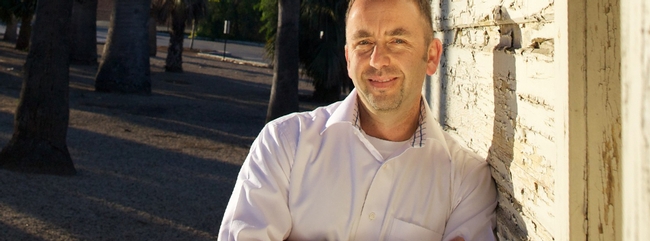
But Mark Hoddle, Extension entomologist and director of the Center for Invasive Species Research at the University of California, Riverside, is.
The Asian citrus psyllid or ACP, a mottled brown insect about the size of an aphid, has emerged as the most important exotic insect pest of citrus in California, and he, along with many others, is targeting it.
Hoddle will speak on “Protecting California Agriculture from Invasive Pests: Biocontrol of Asian Citrus Psyllid in Urban Southern California" when he presents the UC Davis Department of Entomology and Nematology's first seminar of the fall quarter on Wednesday, Sept. 26.
His lecture is from 4:10 to 5 p.m., Wednesday, Sept. 26 in 122 Briggs Hall, announced seminar coordinator Geoffrey Attardo, assistant professor and medical entomologist, UC Davis Department of Entomology and Nematology.
ACP or Diaphorina citri feeds on phloem juice in new leaf growth, deforming the leaves, but more importantly, Hoddle and fellow researchers point out, it vectors the bacterium (Candidatus Liberibacter asiaticus) that causes "the lethal and untreatable citrus disease," huanglongbing (HLB), also called citrus greening disease.
Now researchers are applying an alternative approach, a classical biological control program using two parasitoids from Parkistan. They attack the psyllid nymphs.
As its name implies, the Asian citrus psyllid originated in Asia. It has now spread throughout much of the world, including parts of the Middle East, South and Central America, Mexico and the Caribbean. It was first detected in Florida (Palm Beach County) in 1998, and is now found in Louisiana, Georgia, Arizona, South Carolina, Texas and California. It was first detected in California (San Diego County) in August of 2008. It is a major threat to the multibillion dollar citrus industry in the United States.
The UC Statewide Integrated Pest Management Program has published a Pest Note about the disease and tells how to inspect your citrus trees:
"Homeowners and landscapers can help combat the psyllid by inspecting their citrus trees and reporting new infestations of the Asian citrus psyllid or suspected cases of the disease. The best way to detect the psyllid is by looking at tiny new leaves (feather flush growth) on citrus trees whenever new leaves are forming on the tree. Mature citrus trees typically produce most of their new growth in the spring and fall, but young trees and lemons tend to produce flushes of new growth periodically during warm weather."
"Slowly walk around each tree and inspect the flush growth. Look for signs of psyllid feeding and damage, including twisted leaves, waxy deposits, honeydew, sooty mold, and adult psyllids."
"If you think psyllids are present, use a hand lens to look for small yellow eggs, psyllid nymphs with their waxy tubules, and adults. Immature stages (eggs and nymphs) are limited to tender new leaves and they don't fly, so monitoring efforts are most effective when directed toward these stages on feather flush."
"If you think you have found the insect, immediately contact the CDFA Exotic Pest Hotline at 1-800-491-1899. CDFA staff will tell you if you are in an area that is new to the psyllid or if it is common in your area."
Hoddle, an Extension specialist, received his bachelor's degree (1988) and master's degree (1991) in zoology from the University of Auckland, New Zealand. He holds a doctorate in entomology (1996) from the University of Massachusetts, Amherst.
Since 1997, Hoddle has focused his research on biological control as a tool to reduce the impact of invasive pest species to agriculture, urban and natural areas, with a primary focus on issues affecting California. These programs, he says, often require long periods of overseas research in the home range of the target pest and searching for and studying natural enemies for possible use in biological control.
Hoddle received the Entomological Society of America's "Recognition Award in Entomology" in 2007, after earlier winning the the Pacific Branch of ESA award.
Attardo says that all seminars will take place on Wednesdays at 4:10 in 122 Briggs Hall, located on Kleiber Hall Drive.

Wednesday, Oct. 3
Daniel Karp, assistant professor in the UC Davis Department of Fish, Wildlife, and Conservation Biology: "Harmonizing Biodiversity Conservation with Agricultural Production Across Working Landscapes"
Host: Jay Rosenheim, professor, UC Davis Department of Entomology and Nematology
Wednesday, Oct. 10
Alexander Raikhel, distinguished professor of entomology, UC Riverside: "The Role of Hormone Receptors and MicroRNAs in Mosquito Reproduction and Metabolism"
Host: Geoffrey Attardo
Wednesday, Oct. 17
Arnaud Martin, assistant professor of biology, George Washington University: "Do Butterflies Dream of Genetic Tattoos? Exploring the Genotype-Phenotype Map Using CRISPR"
Host: Geoffrey Attardo
Wednesday, Oct. 24
Naoki Yamanaka, assistant professor, UC Riverside: "A Membrane Transporter Is Required for Cellular Uptake of Ecdysone"
Host: Geoffrey Attardo
Wednesday, Oct. 31
Fred Wolf, assistant professor, UC Merced: (tentative title) "Drunken Drosophila and the Coding of Brain Plasticity"
Host: Joanna Chiu, associate professor and vice chair, UC Davis Department of Entomology and Nematology
Wednesday, Nov. 7
Lark Coffey, assistant professor in the Department of Pathology, Microbiology and Immunology, UC Davis School of Veterinary Medicine: "Zika Virus in Macaques, Mice and Mosquitoes: Contrasting Virulence and Transmissibility in Disparate Hosts"
Host: Geoffrey Attardo
Wednesday, Nov. 14
(No seminar; Entomological Society of America's annual meeting takes place from Nov. 11-14 in Vancouver, B.C.)
Wednesday, Nov. 21
(No seminar; Thanksgiving week)
Wednesday, Nov. 28
Robert Page, Provost emeritus of the University of Arizona and emeritus professor and chair of the UC Davis Department of Entomology and Nematology: "Reverse Engineering Social Structure in Honey Bees: a 25-Year Journey"
Host: Steve Nadler, professor and chair, UC Davis Department of Entomology and Nematology
Wednesday, Dec. 5
Cindy Preto, recent graduate (master's degree in entomology from UC Davis, Frank Zalom lab) "Behavior and Biology of the Three-Cornered Alfalfa Hopper in Vineyards."
Host: Frank Zalom, distinguished professor, UC Davis Department of Entomology and Nematology
For more information on the seminars, contact Attardo at gmattardo@ucdavis.edu.
Attached Images:

The Asian citrus psyllid, about the size of an aphid, is a major threat to the multibillion dollar citrus industry in the United States.(Photo courtesy of the California Department of Food and Agriculture)

Mark Hoddle, Extension entomologist and director of the Center for Invasive Species Research at the University of California, Riverside, will speak on “Protecting California Agriculture from Invasive Pests: Biocontrol of Asian Citrus Psyllid in Urban Southern California" on Sept. 26 at UC Davis. (Photo Courtesy of UC Riverside)